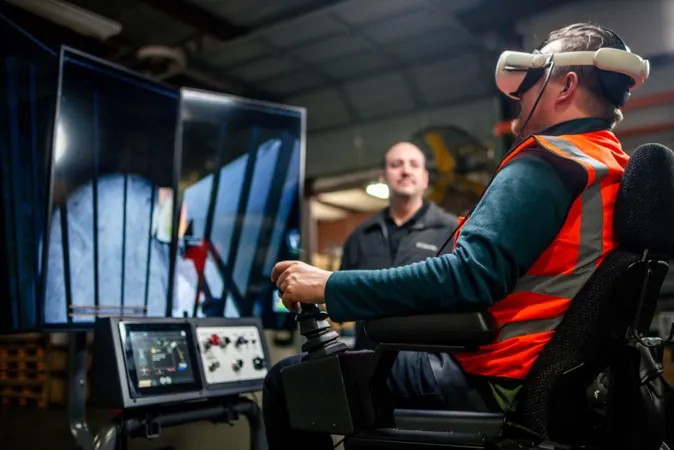
Groundbreaking Study Reveals Insight into Memory Reactivation in Mice—A Pathway to Alzheimer's Research?
2024-10-01
Author: Arjun
Introduction
A pioneering new study conducted by neuroscientists at Johns Hopkins Medicine has illuminated how specific memory circuits in the brain can be reactivated, prompting mice to exhibit shelter-seeking behaviors even in the absence of actual shelter. The findings, published on September 27 in *Nature Neuroscience*, represent a significant advancement in our understanding of memory in mammals, which could have far-reaching implications for tackling memory loss associated with neurodegenerative diseases like Alzheimer's.
Research Focus
The research focused on two crucial regions of the mouse brain: the nucleus accumbens, often dubbed the brain's 'pleasure center' for its role in dopamine-related behaviors, and the dorsal periaqueductal gray (dPAG), which is integral to defensive responses. By stimulating neurons within these areas, the scientists successfully reactivated what they termed a 'spatial memory,' effectively leading the mice to search for shelter.
The Experiment
Hyungbae Kwon, Ph.D., the senior author and an associate professor at Johns Hopkins University School of Medicine, explained, "When we triggered these memory circuits artificially, the mice displayed the same shelter-seeking behaviors that would normally occur in response to fear stimuli, even without a threat present."
Key to this research was the experiment's design, where mice were allowed to explore an enclosure that contained a designated shelter. Researchers placed various colored visual cues, such as triangles and stripes, to assist the mice in mapping their environment. After becoming familiar with this setup, the scientists introduced a looming visual or auditory cue to elicit shelter-seeking behaviors, forming a spatial memory linked to those cues.
Neural Mechanisms Involved
To pinpoint the neurons responsible for shelter memory, the team utilized a cutting-edge light-activated gene expression system known as Cal-light, which Kwon developed in 2017. By selectively activating and tracing these neurons, the researchers were able to demonstrate that reactivation led the mice to seek the shelter area, despite the original shelter and any threats being absent.
Remarkably, when neurons in just the nucleus accumbens were activated, the mice did not engage in shelter-seeking behavior, suggesting the necessity of a combined activation of both neural regions to achieve the desired outcome.
Implications for Neurodegenerative Diseases
Kwon believes this research holds promise for developing techniques to intervene in memory loss conditions, saying, "By understanding the overarching structure of memory and how it functions at the cellular level, we may create more effective strategies to mitigate or delay the onset of neurodegenerative diseases."
Future Research Directions
This groundbreaking study is foundational for future investigations into brain-wide memory structures and functions. The team aims to explore how various memory circuits collaborate, hoping that this will deepen understanding of brain processes and lead to therapeutic advancements for conditions such as Alzheimer's.
Collaboration and Conclusion
In addition to Kwon, several other researchers contributed to the study, including experts from the Max Planck Florida Institute for Neuroscience and Columbia University. This multi-institutional collaboration underscores the crucial need for extensive research into neurodegenerative disorders, which affect millions globally.
As the landscape of neuroscience continues to evolve, studies like this one pave the way for potentially transformative approaches to memory-related illnesses, offering hope for millions affected by conditions such as Alzheimer's. Gain insight into the future of memory research—could we soon rediscover lost memories?


 Brasil (PT)
Brasil (PT)
 Canada (EN)
Canada (EN)
 Chile (ES)
Chile (ES)
 Česko (CS)
Česko (CS)
 대한민국 (KO)
대한민국 (KO)
 España (ES)
España (ES)
 France (FR)
France (FR)
 Hong Kong (EN)
Hong Kong (EN)
 Italia (IT)
Italia (IT)
 日本 (JA)
日本 (JA)
 Magyarország (HU)
Magyarország (HU)
 Norge (NO)
Norge (NO)
 Polska (PL)
Polska (PL)
 Schweiz (DE)
Schweiz (DE)
 Singapore (EN)
Singapore (EN)
 Sverige (SV)
Sverige (SV)
 Suomi (FI)
Suomi (FI)
 Türkiye (TR)
Türkiye (TR)
 الإمارات العربية المتحدة (AR)
الإمارات العربية المتحدة (AR)